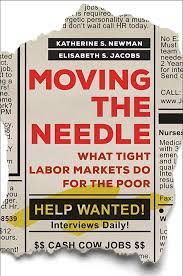Moving the Needle
What Tight Labor Markets Do for the Poor
Katherine S. Newman and Elizabeth S.Jacobs
Most research on poverty focuses on the damage caused by persistent unemployment. But what happens when jobs are plentiful and workers are hard to come by? A timely investigation into sustained tight labor markets, Moving the Needle examines how very low unemployment boosts wages at the bottom, improves benefits, lengthens job ladders, and pulls the unemployed into a booming job market.
Drawing on over seventy years of quantitative data, as well as interviews with employers, jobseekers, and longtime residents of poor neighborhoods, Katherine S. Newman and Elisabeth S. Jacobs highlight the most durable positive consequences of tight labor markets.
Moving the Needle is an urgent and original call to implement policies that will maintain the current momentum and prepare for potential slowdowns that may lie ahead
Published by University of California Press
Praise for Moving the Needle
Astute and timely . . . This is a valuable resource for activists, scholars, and policymakers on the front lines of the battle to end poverty.—Publishers Weekly
Combining expert qualitative craft with quantitative evidence, Moving the Needle provides ideas, insights, and answers regarding how and why high-pressure labor markets reduce joblessness—and how social policy can prolong those benefits even when the pressure abates.—David Autor, Ford Professor of Economics, MIT
One of the few accounts of what happens when jobs are ample and wages are rising. The authors show us how tight labor markets create benefits for all workers, including those often excluded from policymaking. This book is a call to enact policy that builds a stable and fair economy.—Mary Kay Henry, President, Service Employees International Union
Moving the Needle makes the case—through exhaustive interviews with employers, intermediaries, and workers in two communities—for a set of urgent policy actions in the wake of the COVID-19 pandemic to provide low-wage workers with ladders of opportunity that lead to self-sufficiency.—Alicia Sasser Modestino, Professor of Economics at the School of Public Policy and Urban Affairs, Northeastern University
